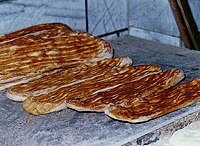Barbari bread
 | |
| Alternative names | Iranian flatbread |
|---|---|
| Place of origin | |
| Region or state | Khorasan |
| Main ingredients | Flour |

Barbari bread (Persian: نان بربری, romanized: nân-e barbari) is a type of yeast leavened Iranian flatbread. It is one of the thickest flat breads and is commonly topped with sesame or black caraway seeds. A notable characteristic of the bread is its top skin that is similar to pretzels or lye roll's skin due to the Maillard reaction that occurs during baking. Before baking it is glazed with a mixture of baking soda, flour and water. It is widely known as Persian flatbread in United States and Canada.[1][2]
Etymology[]
Barbari is an obsolete Persian term for the Hazara people living in Khorasan, Iran. Barbari bread was first baked by Hazaras and taken to Tehran, becoming popular during the Qajar dynasty also called Kajar State, named after azerbaijani turkish tribe. Hazaras are no longer called barbari (i.e. Easterners). As Mongols were considered barbarians and Hazara are largely descended from them hence the term. But the bread is still referred to as nan-e barbari in Iran while Hazaras refer to it as nan-e tanoori (tandoor [tandir] oven bread).[3] It is popular among Iranian Azerbaijanis.
Manufacture and style[]
The bread is usually 70 cm to 80 cm long, and 25 cm to 30 cm wide.[4] It is the most common style baked in Iran. It is served in many restaurants with Lighvan cheese, a ewe's milk cheese similar to feta cheese.[5]
See also[]
- Naan
- Taftan, Iranian bread
- Sangak, a leavened Iranian flatbread
- Lavash, an unleavened Armenian flatbread popular in Iran
References[]
- ^ Ram, Sewa (2009). Cereals: Processing and Nutritional Quality. New India Publishing. p. 27. ISBN 978-9-380-23507-3.
- ^ "Nan-e Barbari". Reform Judaism. Archived from the original on 31 January 2016. Retrieved 4 May 2015.
- ^ "Khomeini's Death Anniversary Sparks Intense Controversy in Kabul". hazara.net. Retrieved 20 July 2018.
- ^ Qarooni, Jalal (2012). Flat Bread Technology. Springer Science & Business Media. p. 75. ISBN 978-1-461-31175-1.
- ^ "Persian Nan o Paneer (Bread with Cheese)". Reform Judaism. Archived from the original on 4 March 2016. Retrieved 1 January 2016.
- Flatbreads
- Iranian breads
- Bread stubs
- Iran stubs
